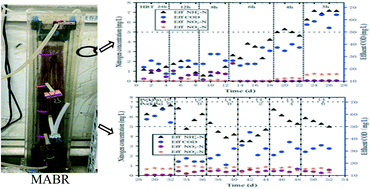Exploring the carbon and nitrogen removal capacity of a membrane aerated biofilm reactor for low-strength municipal wastewater treatment†
Abstract
As a one-stage process capable of simultaneous carbon and nitrogen removal, the membrane aerated biofilm reactor (MABR) has advantages of low energy consumption from bubble-free aeration and no extra carbon dosage for denitrification via the stratified biofilm driven by the counter-diffusion process. The MABR is promising for unique low-strength municipal wastewater treatment in China to meet the stringent discharge standard of level I class A, where chemical oxygen demand (COD), ammonia and total nitrogen must be less than 50, 5 and 15 mg L−1, respectively. This study focused on the simultaneous COD and total inorganic nitrogen (TIN) removal capacity of a lab-scale MABR for synthetic primary effluent of low-strength municipal wastewater in China. Two-step (i.e., nitrifying followed by denitrifying) biofilm enrichment during MABR start-up treating synthetic medium-strength wastewater (COD and ammonia nitrogen of 495 and 103 mg L−1) achieved a COD and TIN removed loading rate of 10.5 and 2.3 g m−2 d−1, respectively. For representative low-strength municipal wastewater (COD and ammonia nitrogen of 270 and 27.5 mg L−1) in China, the MABR could produce effluent with COD and ammonia nitrogen meeting the discharge standard of level I class A under an aeration pressure of 10 kPa and decreasing hydraulic retention time (HRT) of 24 → 4 h, and even under a HRT of 3 h and aeration pressure of 14 kPa. Thus, the sustainable HRT and influent loading rate of the MABR in this study were 3–4 h and 19.4–25.9 gCOD m−2 d−1 and 2.0–2.6 gN m−2 d−1, respectively, where COD and TIN removed loading rates were up to 22.8 and 2.2 g m−2 d−1. COD and ammonia nitrogen removal followed pseudo-first-order and zero-order kinetics, respectively. The rate constant of COD removal increased significantly from 0.226 h−1 during start-up to 0.511 h−1 during HRT of 3 h, which benefited from heterotrophic biofilm growth with operation time. The rate constant of ammonia nitrogen removal decreased slightly from 8.01 mg L−1 h−1 during start-up to 6.68 mg L−1 h−1 during HRT of 3 h, which was ascribed to increased mass transfer resistance of ammonium from bulk diffusion into the inner nitrifying biofilm by excessive growth of the outer heterotrophic biofilm. The MABR demonstrated excellent performance for simultaneous carbon and nitrogen removal for synthetic low-strength municipal wastewater treatment.

- This article is part of the themed collection: Environmental Science: Water Research & Technology Recent HOT Articles


 Please wait while we load your content...
Please wait while we load your content...